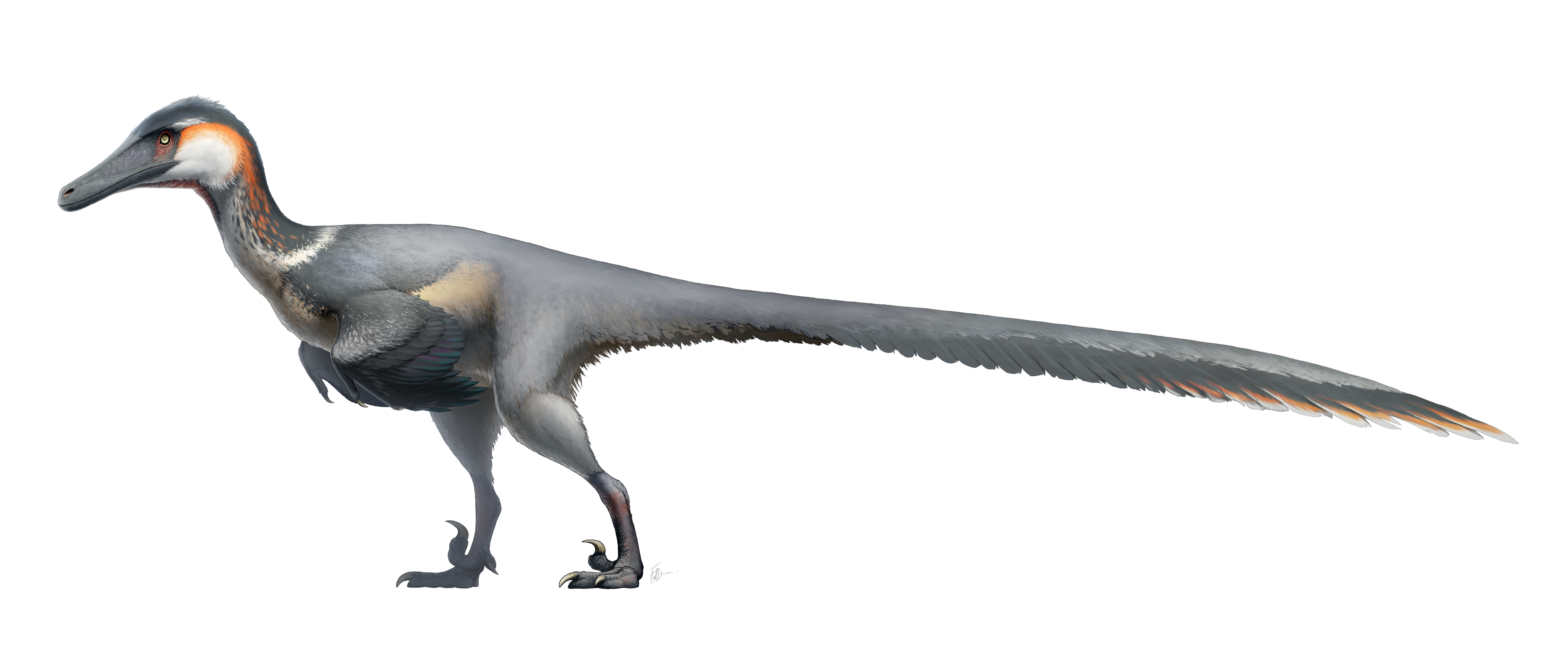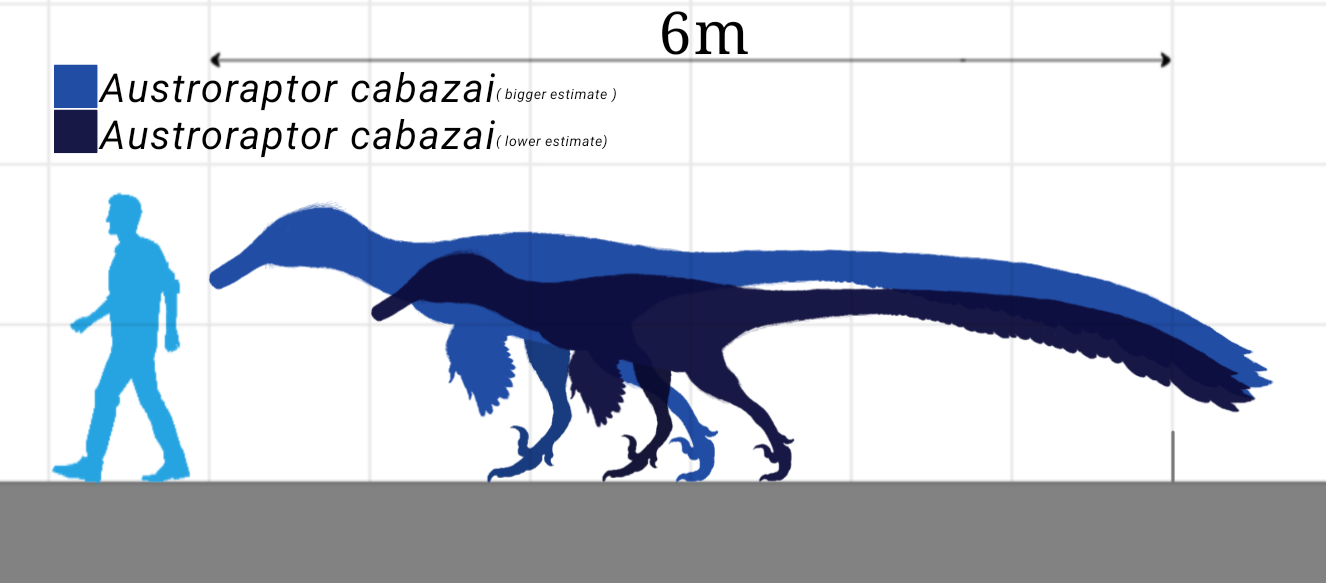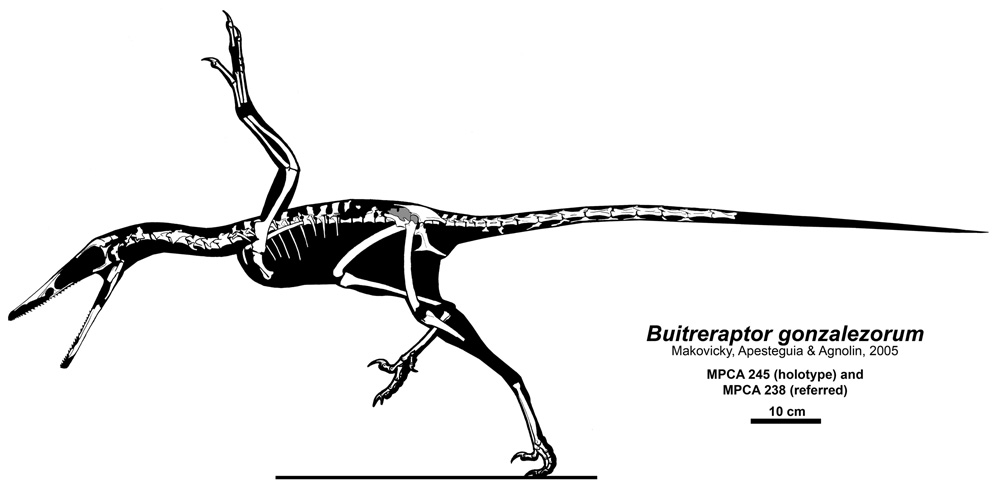|
Unenlagiines
Unenlagiinae is a subfamily of long-snouted Paraves, paravian theropods. They are traditionally considered to be members of Dromaeosauridae, though some authors place them into their own family, Unenlagiidae, sometimes alongside the subfamily Halszkaraptorinae. Definitive members are known from the Late Cretaceous of South America, though some researchers include taxa from other continents within this subfamily based on phylogenetic analyses. Two probable unenlagiine specimens (NMV P257601, NMV P180889) from the upper Strzelecki Group (Aptian) and Eumeralla Formation (lower Albian) of Australia might potentially extend their known fossil range to the Early Cretaceous, and ''Kakuru,'' which is considered a maniraptoran, and might be an unenlagiine as well. ''Imperobator'' from the Late Cretaceous of Antarctica, previously considered enigmatic, has also been recently interpreted as an unenlagiine. Description Most unenlagiines have been discovered in Argentina. The largest was ... [...More Info...] [...Related Items...] OR: [Wikipedia] [Google] [Baidu] |
Austroraptor Restoration
''Austroraptor'' ( ) is a genus of dromaeosaurid Theropoda, theropod dinosaur that lived during the Campanian and Maastrichtian Geologic time scale, ages of the Late Cretaceous Period (geology), period in what is now Argentina. ''Austroraptor'' was a large, moderately-built, ground-dwelling, bipedal carnivore, measuring around long and weighing up to . It is one of the largest dromaeosaurids known, with only ''Achillobator'', ''Dakotaraptor'', and ''Utahraptor'' approaching or surpassing it in length. Discovery and naming The type specimen of ''Austroraptor cabazai'', holotype MML-195, was recovered in the Bajo de Santa Rosa locality of the Allen Formation, in Río Negro (Argentina), Río Negro, Argentina. The specimen was collected in 2002 by the team of Fernando Emilio Novas of the ''Museo Argentino de Ciencias Naturales''. It consists of a fragmentary skeleton including parts of the skull, lower jaw, a few neck and torso vertebrae, some ribs, a humerus, and assorted bones ... [...More Info...] [...Related Items...] OR: [Wikipedia] [Google] [Baidu] |
Austroraptor
''Austroraptor'' ( ) is a genus of dromaeosaurid theropod dinosaur that lived during the Campanian and Maastrichtian ages of the Late Cretaceous period in what is now Argentina. ''Austroraptor'' was a large, moderately-built, ground-dwelling, bipedal carnivore, measuring around long and weighing up to . It is one of the largest dromaeosaurids known, with only '' Achillobator'', '' Dakotaraptor'', and '' Utahraptor'' approaching or surpassing it in length. Discovery and naming The type specimen of ''Austroraptor cabazai'', holotype MML-195, was recovered in the Bajo de Santa Rosa locality of the Allen Formation, in Río Negro, Argentina. The specimen was collected in 2002 by the team of Fernando Emilio Novas of the '' Museo Argentino de Ciencias Naturales''. It consists of a fragmentary skeleton including parts of the skull, lower jaw, a few neck and torso vertebrae, some ribs, a humerus, and assorted bones from both legs. The specimen was prepared by Marcelo Pablo Isasi a ... [...More Info...] [...Related Items...] OR: [Wikipedia] [Google] [Baidu] |
Buitreraptor
''Buitreraptor'' (meaning "La Buitrera seizer") is a genus of dromaeosaurid dinosaurs that lived during the Late Cretaceous of Argentina at the Candeleros Formation. ''Buitreraptor'' was described in 2005 and the type species is ''Buitreraptor gonzalezorum''. It was rooster-sized and had a very elongated head with many small teeth. History of discovery Four specimens of ''Buitreraptor'' were found in 2004 in sandstone in Patagonia, Argentina during an excavation led by Sebastián Apesteguia, researcher of CONICET at the Fundacion Felix de Azara - Maimonides University, and Peter Makovicky, curator of dinosaurs at the Field Museum in Chicago. ''Buitreraptor'' is from the early Late Cretaceous Candeleros Formation, dating to the Cenomanian-Turonian ages approximately 98 to 97 million years ago, when South America was an isolated continent like Australia today. It was uncovered in a famous fossil site named ''La Buitrera'', the "vulture roost". Although dinosaurs are rare in t ... [...More Info...] [...Related Items...] OR: [Wikipedia] [Google] [Baidu] |
Paraves
Paraves are a widespread group of theropod dinosaurs that originated in the Middle Jurassic period. In addition to the extinct dromaeosauridae, dromaeosaurids, troodontidae, troodontids, Anchiornithidae, anchiornithids, and possibly the scansoriopterygidae, scansoriopterygids, the group also contains the Avialae, avialans, which include diverse extinct taxa as well as the over 11,000 species of living birds. Basal members of Paraves are well known for the possession of an enlarged claw on the second digit of the foot, which was held off the ground when walking in some species. A number of differing scientific interpretations of the relationships between paravian taxa exist. New fossil discoveries and analyses make the classification of Paraves an active subject of research. Description Like other theropods, all paravians are bipedal, walking on their two hind legs. The teeth of basal paravians were curved and serrated, but not blade-like except in some specialized species, suc ... [...More Info...] [...Related Items...] OR: [Wikipedia] [Google] [Baidu] |
Early Cretaceous
The Early Cretaceous (geochronology, geochronological name) or the Lower Cretaceous (chronostratigraphy, chronostratigraphic name) is the earlier or lower of the two major divisions of the Cretaceous. It is usually considered to stretch from 143.1 Megaannum#SI prefix multipliers, Ma to 100.5 Ma. Geology Proposals for the exact age of the Barremian–Aptian boundary ranged from 126 to 117 Ma until recently (as of 2019), but based on drillholes in Svalbard the defining Anoxic event#Cretaceous, early Aptian Oceanic Anoxic Event 1a (OAE1a) was dated to 123.1±0.3 Ma, limiting the possible range for the boundary to c. 122–121 Ma. There is a possible link between this anoxic event and a series of Early Cretaceous large igneous provinces (LIP). The Ontong Java Plateau, Ontong Java-Manihiki Plateau, Manihiki-Hikurangi Plateau, Hikurangi large igneous province, emplaced in the South Pacific at c. 120 Ma, is by far the largest LIP in Earth's history. The Onto ... [...More Info...] [...Related Items...] OR: [Wikipedia] [Google] [Baidu] |
Australia
Australia, officially the Commonwealth of Australia, is a country comprising mainland Australia, the mainland of the Australia (continent), Australian continent, the island of Tasmania and list of islands of Australia, numerous smaller islands. It has a total area of , making it the list of countries and dependencies by area, sixth-largest country in the world and the largest in Oceania. Australia is the world's flattest and driest inhabited continent. It is a megadiverse countries, megadiverse country, and its size gives it a wide variety of landscapes and Climate of Australia, climates including deserts of Australia, deserts in the Outback, interior and forests of Australia, tropical rainforests along the Eastern states of Australia, coast. The ancestors of Aboriginal Australians began arriving from south-east Asia 50,000 to 65,000 years ago, during the Last Glacial Period, last glacial period. By the time of British settlement, Aboriginal Australians spoke 250 distinct l ... [...More Info...] [...Related Items...] OR: [Wikipedia] [Google] [Baidu] |
Albian
The Albian is both an age (geology), age of the geologic timescale and a stage (stratigraphy), stage in the stratigraphic column. It is the youngest or uppermost subdivision of the Early Cretaceous, Early/Lower Cretaceous epoch (geology), Epoch/series (stratigraphy), Series. Its approximate time range is 113.0 ± 1.0 annum, Ma to 100.5 ± 0.9 Ma (million years ago). The Albian is preceded by the Aptian and followed by the Cenomanian. Stratigraphic definitions The Albian Stage was first proposed in 1842 by Alcide d'Orbigny. It was named after Alba, the Latin name for Aube (river), River Aube in France. A Global Boundary Stratotype Section and Point (GSSP), ratified by the IUGS in 2016, defines the base of the Albian as the first occurrence of the planktonic foraminiferan ''Hedbergellidae, Microhedbergella renilaevis'' at the Col de Pré-Guittard section, Arnayon, Drôme, France. The top of the Albian Stage (the base of the Cenomanian Stage and Upper Cretaceous Series) is defined ... [...More Info...] [...Related Items...] OR: [Wikipedia] [Google] [Baidu] |
Eumeralla Formation
The Eumeralla Formation is a geological formation in Victoria, Australia whose strata date back to the Early Cretaceous. It is Aptian to Albian in age. Dinosaur remains are among the fossils that have been recovered from the formation, particularly from the Dinosaur Cove locality.Weishampel, David B; et al. (2004). "Dinosaur distribution (Early Cretaceous, Australasia)." In: Weishampel, David B.; Dodson, Peter; and Osmólska, Halszka (eds.): The Dinosauria, 2nd, Berkeley: University of California Press. Pp. 573-574. . Geology The Eumeralla Formation was deposited within the Otway Basin, which at the time of deposition was part of an extensional rift valley system formed between Australia and Antarctica. The lithology primarily consists of fluvially deposited siliciclastics derived from volcanic material. The strata of the Eumeralla Formation are folded as a result of northwest–southeast crustal compression during the Neogene, which also reactivated some Cretaceous aged n ... [...More Info...] [...Related Items...] OR: [Wikipedia] [Google] [Baidu] |
Aptian
The Aptian is an age (geology), age in the geologic timescale or a stage (stratigraphy), stage in the stratigraphic column. It is a subdivision of the Early Cretaceous, Early or Lower Cretaceous epoch (geology), Epoch or series (stratigraphy), Series and encompasses the time from 121.4 ± 1.0 annum, Ma to 113.0 ± 1.0 Ma (million years ago), approximately. The Aptian succeeds the Barremian and precedes the Albian, all part of the Lower/Early Cretaceous. The Aptian partly overlaps the upper part of the Western Europe, Western European Urgonian Stage. The Selli Event, also known as OAE1a, was one of two oceanic anoxic events in the Cretaceous Period, which occurred around 120 annum, Ma and lasted approximately 1 to 1.3 million years, being marked by enhanced silicate weathering, as well as ocean acidification. The Aptian extinction was a minor extinction event hypothesized to have occurred around 116 to 117 Ma. Stratigraphic definitions The Aptian was named after the small city o ... [...More Info...] [...Related Items...] OR: [Wikipedia] [Google] [Baidu] |
Strzelecki Group
The Halibut Field is an oil field, within the Gippsland Basin offshore of the Australian state of Victoria (Australia), Victoria. The oil field is located approximately 64 km offshore of southeastern Australia. The total area of this field is 26.9 km2 and is composed of 10 mappable Geologic unit, units. Geologic history During the late Jurassic, a rift complex forms between the Australian Plate/Tasman Fold Belt, and the Antarctic Plate.Rahmanian, V. D., Moore, P. S., Mudge, W. J., and Spring, D. E., 1990, sequence stratigraphy and the habitat of hydrocarbons, Gippsland Basin, Australia; in Brooks, J., ed., Classic Petroleum Provinces, Geological Society Special Publication No. 50, p 525-541. This rifting continues through the early Cretaceous, and in the middle Cretaceous, begins to assist in the separation of Gondwana (In is what now southern Australia). During this same time, ocean crust is created to the west of Tasmania, and the separation of the Australian Plate ... [...More Info...] [...Related Items...] OR: [Wikipedia] [Google] [Baidu] |
South America
South America is a continent entirely in the Western Hemisphere and mostly in the Southern Hemisphere, with a considerably smaller portion in the Northern Hemisphere. It can also be described as the southern Subregion#Americas, subregion of the Americas. South America is bordered on the west by the Pacific Ocean, on the north and east by the Atlantic Ocean, and to the south by the Drake Passage; North America and the Caribbean Sea lie to the northwest. The continent includes twelve sovereign states: Argentina, Bolivia, Brazil, Chile, Colombia, Ecuador, Guyana, Paraguay, Peru, Suriname, Uruguay, and Venezuela; two dependent territory, dependent territories: the Falkland Islands and South Georgia and the South Sandwich Islands; and one administrative division, internal territory: French Guiana. The Dutch Caribbean ABC islands (Leeward Antilles), ABC islands (Aruba, Bonaire, and Curaçao) and Trinidad and Tobago are geologically located on the South-American continental shel ... [...More Info...] [...Related Items...] OR: [Wikipedia] [Google] [Baidu] |
Late Cretaceous
The Late Cretaceous (100.5–66 Ma) is the more recent of two epochs into which the Cretaceous Period is divided in the geologic time scale. Rock strata from this epoch form the Upper Cretaceous Series. The Cretaceous is named after ''creta'', the Latin word for the white limestone known as chalk. The chalk of northern France and the white cliffs of south-eastern England date from the Cretaceous Period. Climate During the Late Cretaceous, the climate was warmer than present, although throughout the period a cooling trend is evident. The tropics became restricted to equatorial regions and northern latitudes experienced markedly more seasonal climatic conditions. Geography Due to plate tectonics, the Americas were gradually moving westward, causing the Atlantic Ocean to expand. The Western Interior Seaway divided North America into eastern and western halves; Appalachia and Laramidia. India maintained a northward course towards Asia. In the Southern Hemisphere, Aus ... [...More Info...] [...Related Items...] OR: [Wikipedia] [Google] [Baidu] |








